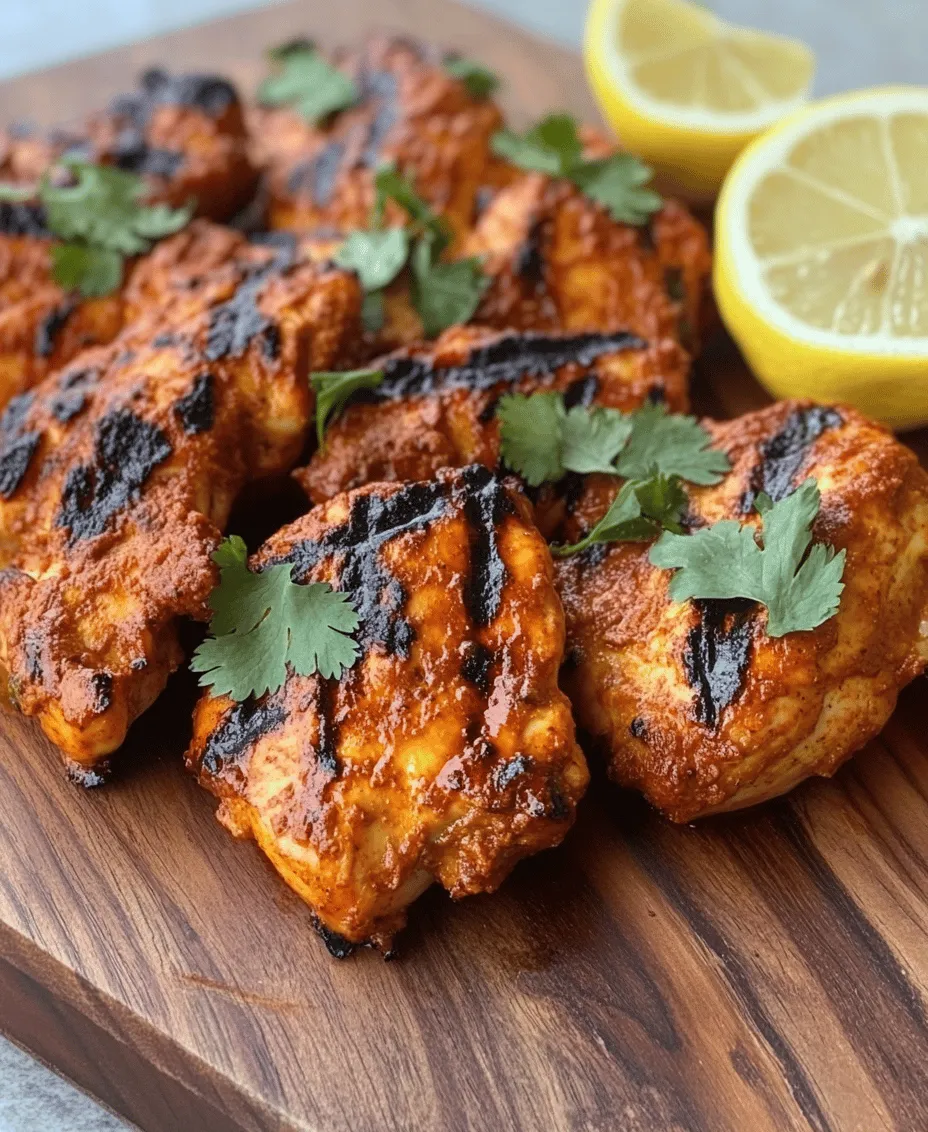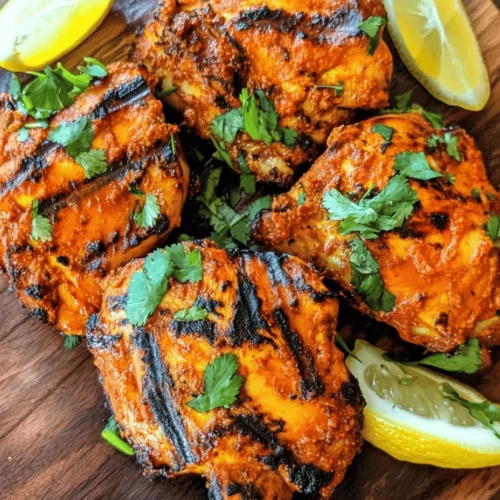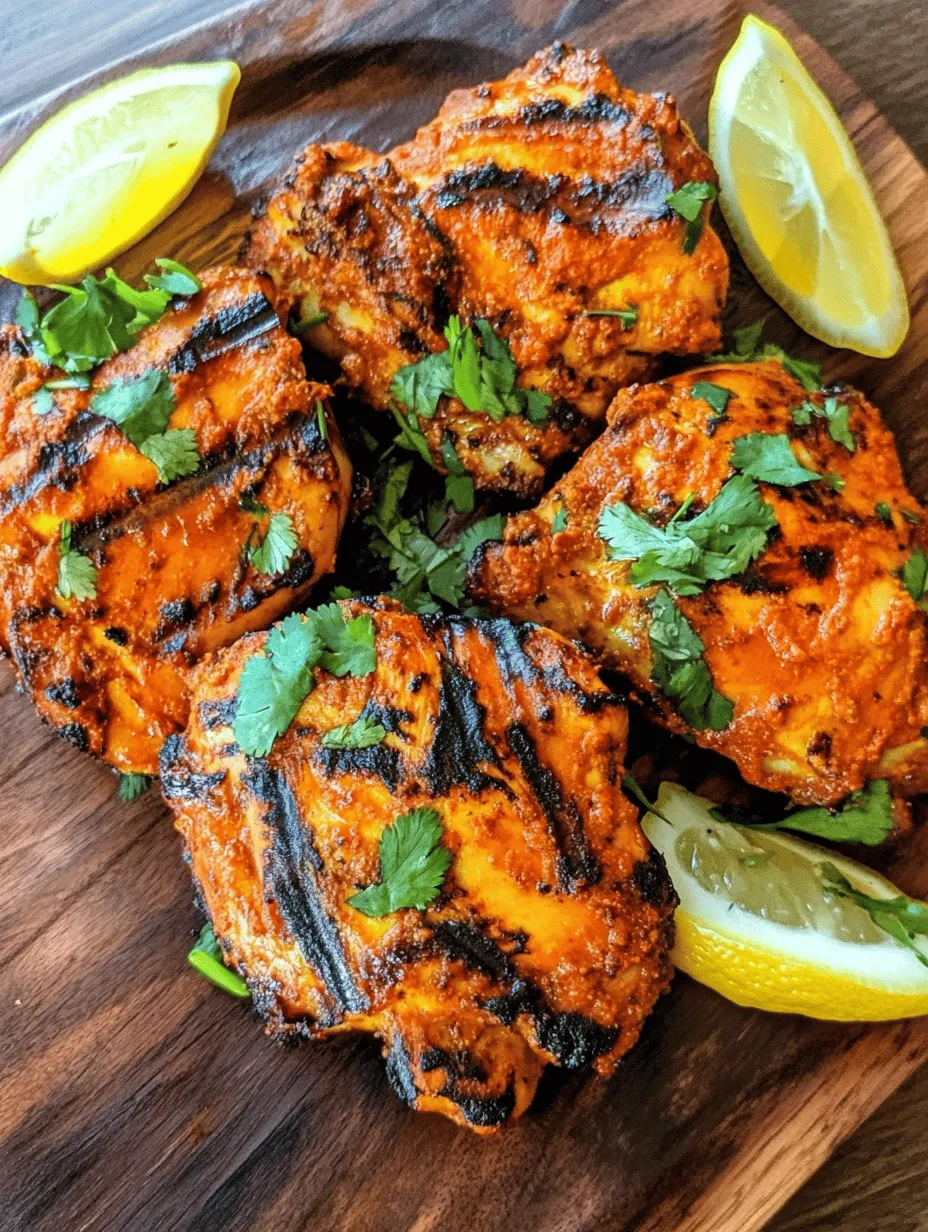Introduction
Tandoori chicken is not just a dish; it is a culinary experience that transports you straight to the heart of Indian cuisine. Renowned for its vibrant flavor and bright red hue, this dish has become a global favorite, gracing tables in homes and restaurants alike. The secret to its irresistible taste lies in the art of marination, which enhances both the flavor and tenderness of the chicken. By allowing the spices and yogurt to work their magic, you create a symphony of tastes that linger long after the last bite.
Moreover, grilling tandoori chicken offers a healthier alternative to traditional frying methods. The grilling process allows excess fat to drip away while imparting a delicious smoky flavor that complements the spices beautifully. Whether you’re hosting a summer barbecue or simply looking to elevate your weeknight dinner, grilled tandoori chicken is a fantastic choice that combines health and flavor in one dish.
In this article, we will delve into the detailed recipe for grilled tandoori chicken, exploring its cultural significance, essential ingredients, and step-by-step marination process. Each part of this journey will reveal why this dish deserves a place on your dining table.
Understanding Tandoori Chicken
Historical Context: Origins of Tandoori Cooking in India
The origins of tandoori cooking can be traced back to the Indian subcontinent, with roots that extend over several centuries. The term “tandoor” refers to a traditional clay oven, which has been used for baking bread and cooking meat. This ancient cooking method likely originated in the regions of Punjab, where the combination of high heat and smoke from burning wood or charcoal creates a unique cooking environment. The tandoor not only cooks food evenly but also infuses it with a distinct flavor that is hard to replicate with other cooking methods.
As Indian cuisine evolved, so did the techniques and spices used in tandoori cooking. Today, tandoori chicken is celebrated worldwide, not just for its taste but also for its cultural significance. It often graces the tables during special occasions, family gatherings, and festivals, symbolizing hospitality and celebration in Indian culture.
Key Ingredients that Define Tandoori Flavor
At the heart of tandoori chicken are its key ingredients, which contribute to its signature flavor and texture. The combination of spices, yogurt, and fresh herbs create a marinade that elevates the chicken to a new level.
– Yogurt: The primary ingredient in the marinade is plain yogurt, which plays a crucial role in tenderizing the meat. The lactic acid in yogurt breaks down the proteins in the chicken, resulting in a juicy and succulent dish. Additionally, yogurt acts as a base for the spices, helping them adhere to the chicken and infusing it with flavor.
– Spices and Herbs: Tandoori chicken is characterized by a blend of spices that give it a rich flavor profile. Common spices include garam masala, cumin, coriander, paprika, turmeric, and cayenne pepper. Each of these spices adds its unique touch, from the warmth of cumin to the kick of cayenne, making every bite a delightful experience.
The Cultural Importance of Tandoori Chicken in Indian Celebrations and Meals
Tandoori chicken holds a special place in Indian culture, often served at weddings, birthdays, and festivals. Its vibrant color and tantalizing aroma make it a centerpiece that draws guests to the table. The dish embodies the essence of Indian hospitality, where sharing food is a way of expressing love and care.
Moreover, tandoori chicken is not just limited to special occasions. Many families enjoy this dish as part of their everyday meals, often served with naan or rice and accompanied by chutneys or salads. Its versatility allows it to be paired with various sides, making it a beloved staple across different regions of India.
Ingredients Breakdown
To create the perfect grilled tandoori chicken, it’s essential to understand the ingredients that go into the marinade. Each component plays a vital role in achieving the dish’s signature taste and texture.
Chicken Thighs: Why Bone-in and Skinless Are Preferred
For the best results, bone-in and skinless chicken thighs are recommended. The bone helps retain moisture, preventing the meat from drying out during grilling. Moreover, thighs are generally more flavorful and tender compared to chicken breasts, making them an ideal choice for this recipe. If you prefer a leaner option, you can use chicken breasts, but be mindful of cooking times to avoid drying them out.
Yogurt: Importance of Plain Yogurt in Marination
Plain yogurt is the cornerstone of the marinade, providing both flavor and tenderness. It’s important to use full-fat or whole yogurt, as the creaminess adds richness to the dish. Avoid flavored or sweetened yogurts, as they can alter the taste of the marinade. The yogurt’s acidity not only helps tenderize the chicken but also balances the spices, creating a harmonious blend that penetrates the meat.
Spices: Explanation of Key Spices in Tandoori Flavor
The spices used in the tandoori marinade are what set this dish apart. Here are the key spices and their roles:
– Garam Masala: A fragrant spice blend that typically includes cardamom, cinnamon, and cloves, garam masala adds warmth and complexity to the flavor profile.
– Cumin: Known for its earthy and nutty flavor, cumin enhances the depth of the marinade, providing a robust base.
– Coriander: This spice adds a citrusy note that brightens the overall flavor, balancing the richness of the yogurt and the warmth of the other spices.
– Paprika: For a mild sweetness and vibrant red color, paprika is essential. It contributes to the dish’s signature hue while enhancing the visual appeal.
– Turmeric: Known for its health benefits, turmeric adds a warm, golden color and a subtle earthiness to the marinade.
– Cayenne Pepper: This spice lends a kick of heat to the dish, adjustable to your taste preferences. If you prefer a milder flavor, you can reduce the amount or opt for a less spicy chili powder.
Optional Garnishes: Fresh Cilantro and Lemon Wedges
While the grilled tandoori chicken is delicious on its own, garnishing with fresh cilantro and serving lemon wedges can elevate the presentation and flavor. The brightness of the lemon juice adds a refreshing contrast to the rich spices, while cilantro imparts a burst of freshness that complements the dish beautifully.
Suggestions for Ingredient Substitutions
If you’re unable to find certain ingredients, here are a few substitutions you can consider:
– Chicken Thighs: You can use chicken drumsticks or breasts instead of thighs. Just adjust the cooking time accordingly.
– Plain Yogurt: If you don’t have plain yogurt, you can substitute it with buttermilk or a dairy-free alternative like coconut yogurt.
– Spices: While the specific spices are recommended to achieve authentic flavor, you can experiment with pre-made tandoori spice blends if you’re short on time.
Marination Process
Importance of Marination Time for Flavor Infusion
Marination is a crucial step in preparing grilled tandoori chicken. The longer the chicken sits in the marinade, the more pronounced the flavors will be. Ideally, you should aim for at least 4 hours of marination, but overnight is recommended for maximum flavor. This allows the spices to penetrate deeply into the chicken, ensuring that each bite is packed with the rich, aromatic tastes that tandoori chicken is known for.
Step-by-Step Guide to Creating the Marinade
Creating the marinade for grilled tandoori chicken is a straightforward process. Follow these steps to ensure you achieve the perfect consistency and flavor:
1. Prepare the Chicken: Begin by cleaning the chicken thighs and patting them dry with paper towels. This step is essential as it helps the marinade adhere better.
2. Mix the Marinade: In a large mixing bowl, combine the plain yogurt, garam masala, cumin, coriander, paprika, turmeric, cayenne pepper, and salt. Stir well until all the spices are fully incorporated into the yogurt.
3. Add Aromatics: For an extra layer of flavor, you can add minced garlic and ginger to the marinade. These ingredients bring a fragrant aroma and depth to the dish.
4. Coat the Chicken: Add the chicken thighs to the marinade, ensuring that each piece is thoroughly coated. You can use a spoon or your hands (wearing gloves) to massage the marinade into the chicken, making sure it gets into all the nooks and crannies.
5. Marinating Time: Cover the bowl with plastic wrap or transfer the chicken to a resealable plastic bag. Place it in the refrigerator and let it marinate for at least 4 hours or overnight for the best results.
6. Prepare for Grilling: Once the marination time is complete, remove the chicken from the refrigerator about 30 minutes before grilling to allow it to come to room temperature. This step ensures even cooking.
By following these steps, you will set the stage for a mouthwatering grilled tandoori chicken that is sure to impress your family and friends. In the next part of this article, we will explore the grilling process, including tips to achieve that perfect char and smoky flavor. Stay tuned for the delicious conclusion to this culinary journey through Indian cuisine!

Mixing the Ingredients: Tips for Ensuring an Even Blend
To create the perfect marinade for Grilled Tandoori Chicken, it’s essential to ensure that all ingredients are thoroughly mixed. Begin by combining the yogurt, spices, and any additional ingredients in a large mixing bowl. A whisk or a fork works well for this process, allowing you to break up any clumps of spices and ensure a smooth, cohesive mixture. Incorporating the garlic and ginger paste will add a fragrant depth to the marinade, while ensuring that the spices are evenly distributed will guarantee that every bite of chicken is flavorful.
One helpful tip is to add the dry spices gradually, mixing them into the yogurt base step by step. This method not only allows you to control the flavor intensity but also helps in achieving a uniform consistency. It’s advisable to taste the marinade before adding the chicken; this way, you can adjust the seasoning to your preference, whether that means adding more salt, heat, or acidity from lemon juice.
Best Practices for Marinating Chicken: Covering and Refrigerating
Once your marinade is ready, it’s time to focus on the chicken. Cut your chicken into pieces if you haven’t already, as this will help the marinade penetrate more deeply, ensuring flavor throughout. Place the chicken in a large resealable plastic bag or a glass dish, pouring the marinade over it. Make sure the chicken is completely coated.
Cover the dish with plastic wrap or seal the bag tightly, removing as much air as possible. This prevents contamination and keeps the chicken moist during marination. Refrigerate the chicken for the duration of the marinating process. The cool temperature of the fridge helps to prevent bacterial growth while allowing the flavors to meld beautifully.
Recommendations for Marinating Overnight Versus a Few Hours
For optimal flavor and tenderness, marinating your Tandoori chicken overnight is highly recommended. The extended time allows the spices to infuse more deeply into the meat, resulting in a richer taste. However, if you’re short on time, marinating for at least 2-4 hours can still yield delicious results. Just be aware that the longer you marinate, the more the acidity from the yogurt will tenderize the chicken.
If marinating for a shorter duration, consider using a slightly more intense spice blend to ensure the flavor stands out. Regardless of the time you choose, ensure that you keep the chicken refrigerated and discard any leftover marinade that has come into contact with raw chicken to maintain food safety.
Grilling Techniques
Preparing the Grill: Tips for Preheating and Achieving the Right Temperature
The key to perfectly grilled Tandoori chicken lies in proper grill preparation. Begin by preheating your grill to a medium-high temperature, around 400°F to 450°F (205°C to 232°C). This ensures that the chicken will sear properly, creating that coveted charred exterior while keeping the inside juicy.
If you’re using a charcoal grill, allow the coals to burn until they are covered in white ash before placing the chicken on the grill grates. For gas grills, simply turn on the burners and close the lid to trap the heat. Always check the grill grates for cleanliness; brushing them before preheating will prevent the chicken from sticking.
Techniques for Grilling Chicken: Ensuring Even Cooking and Avoiding Dryness
When it comes to grilling chicken, even cooking is crucial. To achieve this, place the marinated chicken pieces on the grill, ensuring there’s enough space between each piece for heat to circulate. Avoid overcrowding the grill, as this can lead to uneven cooking.
Use a pair of tongs to flip the chicken only once or twice during grilling. This minimizes the risk of tearing the skin or causing the chicken to lose moisture. Additionally, consider using a meat thermometer to monitor the internal temperature; chicken should reach an internal temperature of 165°F (75°C) to ensure it is fully cooked and safe to eat.
Duration and Temperature Guidance: Importance of Internal Cooking Temperature
The grilling duration will vary based on the size of your chicken pieces. Generally, bone-in chicken pieces will take about 30-40 minutes, while boneless chicken may require only 15-25 minutes. Always keep a close eye on the chicken, using a meat thermometer for the most accurate results. Once the chicken reaches the safe internal temperature of 165°F (75°C), it’s ready to be removed from the grill.
Discussing the Use of Leftover Marinade: Safety and Flavor Enhancement
It’s common to wonder about using leftover marinade. While it can enhance the flavor of your grilled chicken, it’s crucial to handle it safely. If you plan to use the marinade as a baste during grilling, reserve a portion before adding the raw chicken. This prevents cross-contamination. If you wish to use the marinade as a sauce after cooking, ensure it is brought to a boil to kill any harmful bacteria.
Serving Suggestions
Ideal Accompaniments to Tandoori Chicken
When serving Grilled Tandoori Chicken, consider pairing it with traditional accompaniments to enhance the overall dining experience. Classic Indian side dishes like cucumber raita, a cooling yogurt-based condiment, help to balance the spices in the chicken beautifully. This refreshing side serves to cleanse the palate while adding a creamy texture to each bite.
Naan Bread Versus Rice: Cultural Preferences and Flavors
The choice between naan and rice often comes down to personal preference. Naan, a soft and fluffy flatbread, is perfect for scooping up pieces of chicken and raita, making it a favorite choice for many. Alternatively, serving the Tandoori chicken over basmati rice creates a satisfying meal that absorbs the flavors of the marinade. Both options are excellent, so choose based on your taste or what you have on hand.
Suggested Side Dishes: Cucumber Raita or Salad
In addition to raita and your choice of bread or rice, consider including a simple salad made with fresh vegetables, such as carrots, cucumbers, and tomatoes, dressed lightly with lemon juice and salt. This can provide a crunchy contrast to the tender chicken and rich side dishes, making for a more well-rounded meal.
Presentation Tips: Making Your Grilled Tandoori Chicken Visually Appealing
When it comes to presentation, a visually appealing dish can elevate your dining experience. Arrange the grilled Tandoori chicken on a large platter, garnished with fresh cilantro, lemon wedges, and colorful slices of onion. The vibrant colors will not only make the dish more appetizing but also showcase the authenticity of the flavors. Serve alongside your chosen sides, allowing guests to create their own plates.
Nutritional Benefits of Grilled Tandoori Chicken
Overview of Health Benefits Associated with the Ingredients
Grilled Tandoori Chicken is not only delicious but also offers numerous health benefits. The primary ingredient, chicken, is a lean source of protein, essential for muscle repair and overall body function. The spices used in Tandoori cooking, such as turmeric and cumin, contain anti-inflammatory properties and are known to support digestion.
Lean Protein Content of Chicken
Chicken is an excellent source of lean protein, making it a favored choice for those looking to maintain a healthy diet. Protein is vital for building and repairing tissues, and it plays a crucial role in producing enzymes and hormones. Grilled chicken, when prepared without excessive fat or heavy sauces, remains a low-calorie option that satisfies hunger without compromising on nutrition.
Benefits of Yogurt and Spices for Digestion and Metabolism
The yogurt in the Tandoori marinade not only contributes creaminess but also promotes gut health due to its probiotic content. Yogurt can aid digestion, improve gut health, and enhance nutrient absorption. The spices in the marinade, such as ginger and garlic, can further support digestion and metabolic functions, making this dish a health-conscious choice.
Comparison of Grilled Tandoori Chicken Versus Fried or Heavily Sauced Chicken Dishes
When comparing Grilled Tandoori Chicken to fried or heavily sauced chicken dishes, the nutritional advantages become clear. Fried chicken is often laden with unhealthy fats and excess calories, while Tandoori chicken offers a flavorful alternative that retains the essence of Indian cuisine without compromising health. The grilling method allows excess fat to drip away, resulting in a dish that’s both satisfying and wholesome.
Conclusion
Preparing and enjoying Grilled Tandoori Chicken is not just about satisfying hunger; it’s an exploration of flavors that invites you to dive into the rich culinary traditions of Indian cuisine. The joy of cooking this dish lies in the marination process, where spices blend harmoniously with the chicken, creating a delightful taste experience.
Encouraging you to explore homemade recipes not only enhances your cooking skills but also deepens your appreciation for the cultural significance of meals like Tandoori chicken. Sharing this dish with friends and family fosters a sense of community, connecting people through the universal language of food. Embrace the vibrant flavors of India by trying your hand at this exciting recipe, and savor every moment of the experience!



